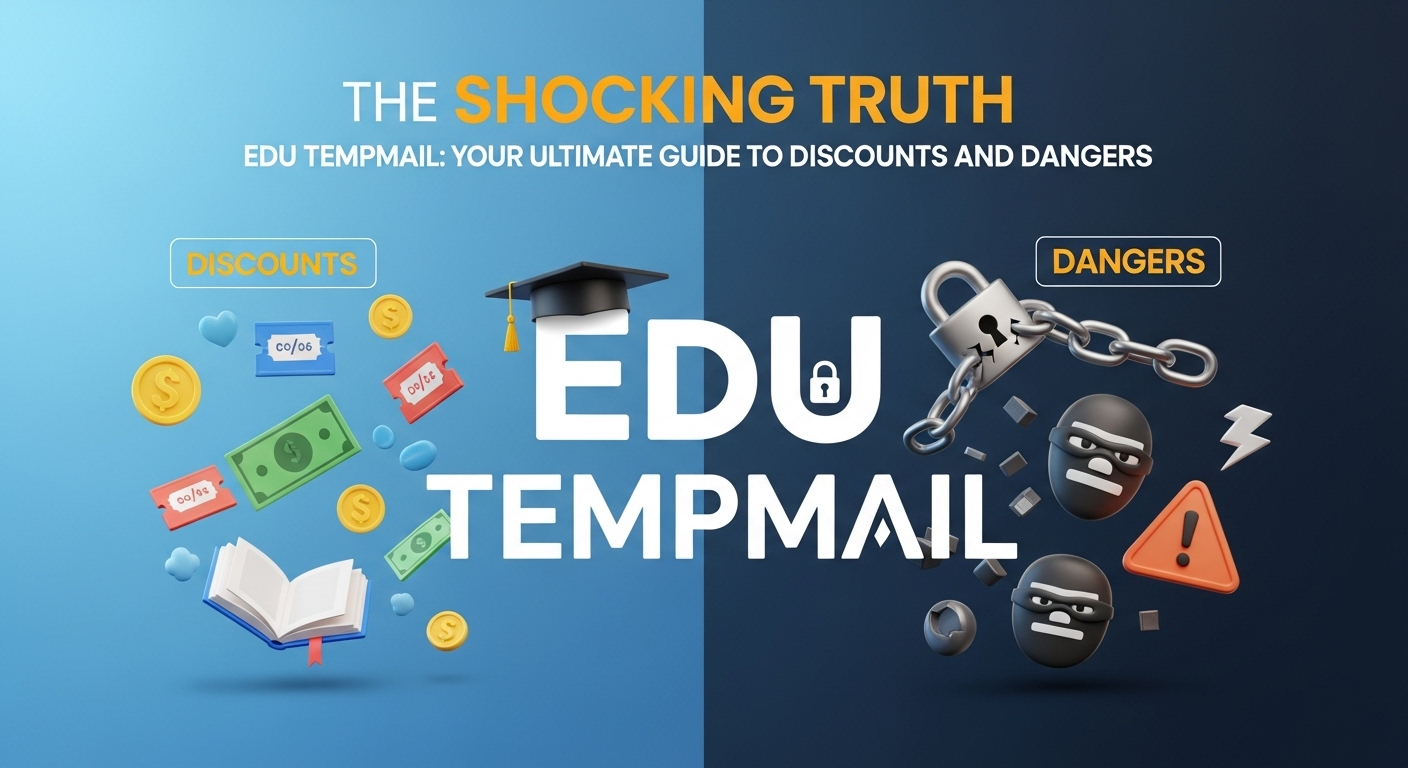The Ultimate Deception: Is Tempmail Safe, or a Ticking Time Bomb?

Your email inbox is more than just a place for messages. It's the digital key to your entire online life. Every password reset, bank notification, and personal conversation lives there. Unfortunately, this makes it a prime target for cybercriminals.
Consider this staggering fact: on average, a mind-boggling 3.4 billion phishing emails are sent every single day. When these attacks succeed, the cost is immense. The average data breach resulting from a phishing attack costs a company $4.88 million. And it's not just big corporations at risk; the "human element" is a factor in 68% of all data breaches, meaning regular people are the primary targets.
Every time you sign up for a newsletter, download a free e-book, or join a new service, you expose your primary email to this hostile environment. This is where temporary email services enter the picture, offering a shield against the endless storm of spam and data breaches. It's a clever solution, but the critical question remains: is tempmail safe enough to trust with your digital life?
What is a Temporary Email? Unmasking the "Burner" Account
A temporary email is exactly what it sounds like: a disposable email address designed for short-term use. Think of it as a digital PO box that automatically self-destructs after a set time. You get an email address instantly, without any registration, and it vanishes after a few minutes or hours.
The core function is simple: you visit a provider's website, and a ready-to-use email address is generated for you on the spot. It’s designed purely for receiving messages, like verification codes or confirmation links, not for long-term communication or storage. This convenience is its biggest draw, but as we'll see, it's also directly linked to its greatest risks.
The Siren's Call: Top Reasons People Use Temp Mail
So, why do millions of people turn to these services? The reasons are almost always defensive—a way to reclaim control in an online world that constantly demands our data.
- Dodging the Spam Tsunami: This is the number one reason. Use a temp mail for store loyalty cards, one-off downloads, or newsletters to keep your main inbox clean and clutter-free.
- Guarding Your Online Privacy: Every time you use your real email, you're helping companies build a detailed profile about you. Using different disposable addresses for different services makes it much harder for them to track you and protects your real identity if one of those services suffers a data breach.
- Testing Websites and Apps Risk-Free: Developers and curious users alike use disposable emails to test sign-up processes and app features without flooding their personal inboxes with notifications.
- Claiming One-Time Offers: Want to access a free trial, discount code, or e-book without committing to a lifetime of marketing emails? A burner account is the perfect tool.
- Maintaining Anonymity: When you want to join a forum, post a comment, or use a public Wi-Fi spot without tying the activity to your real-world identity, a temporary email provides a valuable layer of separation.
The Million-Dollar Question: So, Is Tempmail Safe to Use?
Here is the direct answer you're looking for: Yes, tempmail is generally safe for its intended, low-stakes purpose. However, it is fundamentally unsecure for anything important or sensitive.
To understand this, you must grasp the critical difference between privacy and security.
- Privacy (What Temp Mail is GOOD for): This is about anonymity. A temporary email is a privacy tool because it hides your real identity. It acts as a shield, preventing companies from linking your online activities back to you and protecting your main inbox from spam.
- Security (What Temp Mail is BAD for): This is about data protection. A secure system ensures that only you can access your information and that you can recover your account if needed. Temp mail fails spectacularly here. It's a shield with no lock.
Think of it this way: Using a temp mail is like giving a stranger a key to a public locker. It’s fine if you just need them to drop off a flyer you'll glance at once. But you would never ask them to hold your passport, your credit card, or the keys to your house.
The Hidden Traps: Critical Risks of Using Disposable Email
That convenience comes at a steep price. Before you use a disposable email for your next sign-up, you need to be aware of the hidden traps. These aren't minor issues; they are fundamental flaws that can lead to serious consequences.
- The "No Way Back" Problem: This is the biggest risk. If you use a temp mail for any account and forget the password, you are permanently locked out. There is no password reset link, no two-factor authentication code, and absolutely no way to recover your account. It's gone forever.
- The Illusion of Anonymity: While it hides your real email, many services log your IP address and browser details. True anonymity is not guaranteed unless you take extra precautions.
- Public Inboxes: Many free services use public or easily guessable inboxes. This means a complete stranger could potentially read your verification codes or confirmation emails. It's like having your mail delivered to an unlocked box on a public street.
- The Lack of Encryption: Most free providers do not use end-to-end encryption. Your messages sit on their servers in plain text, readable by the provider or anyone who compromises their system.
- The Blacklist: Many popular websites and services know about these providers and actively block sign-ups from known disposable email domains. You might find your registration rejected before you even start.
- Data Misuse: Remember the old saying: "If you're not paying for the product, you are the product." Some "free" services may be monetizing your data by selling browsing habits or even the contents of emails to third parties.
Temp Mail Safety: A Head-to-Head Comparison
To make the choice clear, here’s a simple breakdown of the pros and cons. This scorecard helps you see exactly what you're gaining and what you're giving up.
| Advantages (The Privacy Shield) | Disadvantages (The Security Gamble) |
| ✅ Excellent Spam Protection: Keeps your primary inbox clean from marketing and junk mail. | ❌ Zero Account Recovery: Permanent lockout if you lose a password or need a 2FA code. |
| ✅ Enhanced Anonymity: Hides your real identity during sign-ups for non-essential services. | ❌ Weak or No Encryption: Messages can be read by the provider or intercepted. |
| ✅ Instant & Free: No registration or personal information required for immediate use. | ❌ Public Inbox Risk: Inboxes may be publicly accessible or guessable, exposing your messages. |
| ✅ Reduces Digital Footprint: Limits the amount of data companies can collect and link to you. | ❌ Frequently Blocked: Many websites actively reject sign-ups from disposable email domains. |
| ✅ Convenient for Testing: Perfect for developers or users testing new applications safely. | ❌ Potential Data Logging: The service may log your IP address, undermining true anonymity. |
Smart User Playbook: How to Use Temp Mail Safely
If you decide the benefits outweigh the risks for a specific task, follow these rules to protect yourself. Using a temp mail safely requires a shift in mindset: treat it not as an inbox, but as a disposable message drop-point.
- Rule #1: The Golden Rule - Never for Sensitive Accounts. This is non-negotiable. Do not use a temporary email for banking, social media, online shopping, government services, or anything that involves your money or personal identity.
- Rule #2: Choose Your Provider Wisely. Not all services are created equal. Use a reputable service that has a clear privacy policy and a history of reliability. Take two minutes to read their terms—it's worth it.
- Rule #3: Use a VPN for an Extra Layer of Anonymity. A Virtual Private Network (VPN) masks your real IP address from the temp mail provider, adding another strong layer of privacy to your activity.
- Rule #4: Assume Nothing is Private. Treat any message sent to a temp mail address as if it were written on a public postcard. Never include names, phone numbers, or other personal details.
- Rule #5: Clean Up After Yourself. After you’re done, clear your browser's cookies and cache to remove traces of your session.
Beyond the Burner: Exploring Safer, More Powerful Alternatives
The good news is that you don't have to choose between a spam-filled inbox and a risky, insecure one. There are far better tools available that offer the same benefits without the dangerous trade-offs.
- Email Aliases: This is the best solution for most people. Services like(https://simplelogin.io), AnonAddy, or features built into secure providers like Proton Mail and Apple's Hide My Email let you create unique "alias" addresses that forward to your real inbox.
- Why it's better: You own the alias. You can send and reply from it. It forwards to your secure, private inbox. And if an alias starts getting spammed, you can simply turn it off. It gives you all the control and none of the risk.
- A Dedicated Secondary Account: The classic "junk" email account. Creating a separate Gmail or Outlook account just for sign-ups is a simple and effective strategy. It's more work than an alias, but it's infinitely more secure than a public temp mail service because you own it, it’s password-protected, and you can recover it if you get locked out.
The Final Verdict: Should You Use Temp Mail?
So, back to our original question: is tempmail safe?
The verdict is clear. Temp mail is an excellent tool for protecting your privacy in low-stakes, disposable situations. It is a terrible and dangerous tool for ensuring your security and should never be used for anything you might need to access again.
Use the right tool for the right job. Use a disposable email when you need a quick, anonymous shield for a one-time interaction. But for everything else, invest five minutes in setting up a safer alternative like an email alias. Protect your privacy, but never, ever gamble with your security.
Your Questions Answered: The Ultimate Temp Mail Safety FAQ
- Can temp mail be traced?
It's difficult, but not impossible. The service provider may log your IP address. With a legal order, law enforcement could potentially trace it back to you. For better anonymity, always use a reputable VPN.
- How long does a temporary email last?
It varies widely by provider. Some last only 10 minutes, while others can last for hours or even days. Most services automatically delete messages after a short period.
- Are temporary emails illegal?
No. Using temporary emails for legitimate purposes like avoiding spam and protecting your privacy is perfectly legal. However, using them to conduct illegal activities is, of course, against the law.
- Can I send emails from a temp mail address?
Usually, no. The vast majority of free services are receive-only. A few providers offer limited sending capabilities, but it is not a standard feature.
- What is the most secure temporary email?
The most secure option isn't a "temporary email" in the traditional sense, but an email alias from a secure, encrypted email provider. This gives you permanent control and robust security that public temp mail services cannot offer.
- Should I use temp mail for Facebook or other social media?
It is highly discouraged. If you ever get locked out or forget your password, you will have no way to receive a reset link and will lose access to your account forever.
- Is temp mail safe for online purchases?
Absolutely not. You won't reliably receive order confirmations, shipping updates, or digital receipts. More importantly, you risk exposing transaction details in an unencrypted, and possibly public, inbox.
- Do temp mail services store my emails?
They store them temporarily on their servers until they are deleted. Because these emails are rarely encrypted, you should assume the provider (or anyone who hacks them) can read your messages.
- What's the difference between a temp mail and a fake email?
A temp mail is a real, working (but temporary) address that can receive mail. A "fake email" is often just a made-up address (like [email protected]) that doesn't work at all and will cause any message sent to it to bounce.
- Why do websites block temp mail?
Websites block disposable email domains to reduce fraud, prevent users from abusing free trials with multiple accounts, and ensure they have a reliable, long-term way to communicate with their users.
- Can I recover a temp mail account?
No. This is the most critical risk. Once the email address expires or your browser session ends, it is gone forever. There is no recovery process.
You Might Also Like
Is Your Inbox Spying on You? Here’s How AdGuard Tempmail Fights Back
Have you ever paused before entering your email address into a new website, feeling a slight hesitation? That feeling is...

The Shocking Truth About Edu Tempmail: Your Ultimate Guide to Discounts and Dangers
Imagine getting over 60% off Adobe Creative Cloud and half-price Amazon Prime. What if you could get those deals without...

Why Your Hotmail Is a Privacy Nightmare (And How Temp Mail Can Save You)
Did you know that nearly half of all emails sent worldwide are spam? In 2024, spam accounted for a staggering 47.27% of ...

The Ultimate Betrayal: How Your Inbox Is Selling You Out (And How to Use Tempmail to Stop It)
Your inbox is a battlefield. Every single day, a war is waged for your attention, your data, and your money. Don't belie...

Your Digital Shield: The Astonishing Truth About How Temp Mail Works
Opening your email inbox can feel like walking into a battlefield. You’re constantly dodging a barrage of promotional ju...

The Ultimate Betrayal: Is Your Temporary Email Secretly Exposing You?
Ever feel like your email inbox is a public battlefield? You’re not alone. Every single day, an estimated 3.4 billion ph...

